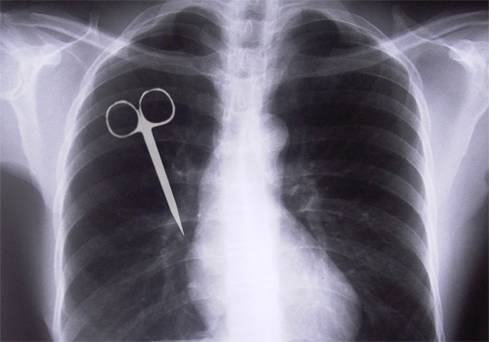 Complications & Symptoms of Retained Surgical Items | Common Types of Retained Surgical Instruments | MedicalMalpracticeHelp.com: Malpractice Legal Help
Complications & Symptoms of Retained Surgical Items | Common Types of Retained Surgical Instruments | MedicalMalpracticeHelp.com: Malpractice Legal Help
Types of Retained Surgical Instruments
One of the most common types of retained surgical instruments is gossypiboma, or a retained sponge or towel. Gossypiboma is difficult to diagnose and can be easily mistaken for an abscess, especially after an extended amount of time has passed. Both abscesses and retained surgical sponges and towels show air bubbles on test results such as a CT scan. Furthermore, X-rays often fail to provide clear results or solid evidence. Symptoms can be so vague and inconsistent that the condition is not diagnosed for several years.

Other types of retained surgical instruments include:
- Gauze
- Clamps
- Tweezers
- Forceps
- Scopes
- Needles
- Safety pins
- Knife blades
- Scalpels
- Scissors
- Measuring devices
Complications of Retained Surgical Instruments
Complications of retained surgical instruments can range from harmless to fatal. In some cases, symptoms and manifestations of a retained surgical instrument can be mild without causing related health complications. However, serious complications can develop. Retained surgical sponges can rot, collect pus and bacteria, and cause ulceration that grows increasingly life-threatening. Sharp objects such as a blade or scalpel can lead to organ and blood vessel punctures that cause internal bleeding.
One of the main complications noted is the excessive costs associated with removing a retained surgical instrument. Once a retained surgical instrument is detected, additional surgery is typically needed. Occasionally, misdiagnosis of a retained object can lead to unnecessary extreme surgery that uses excessive money, time, and resources of both the patient and the medical facility. Additionally, time spent removing a retained surgical instrument subtracts from time that can be used to treat other patients with potentially more urgent conditions.
Methods for Prevention
While retained surgical instruments are classified as a preventable medical error that should never occur, it is estimated to occur in roughly 1,000 to 1,500 abdominal surgeries. One of the most common methods used to prevent retained surgical instrument occurrences is counting. Counting requires that all objects involved in an operation are counted before and after the surgery has taken place. However, this prevention method is not 100% effective as it is prone to human error.
While metal tools such as scissors and tweezers can be seen in an X-ray, new technologies are being developed to reduce the occurrence of retained surgical instruments such as sponges and towels. In radiopaque marking, sponges are soaked with“radiopaque marker” before the surgery. The radiopaque markerallows them to be easily seen on a radiograph. Barcode scanning systems became available in 2006 to take inventory of sponges. Radiofrequency systems use a tag inside sponges that can be detected from wands held against the patient’s body.
Sources:
